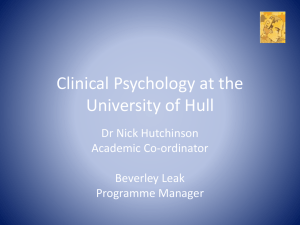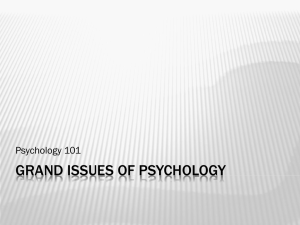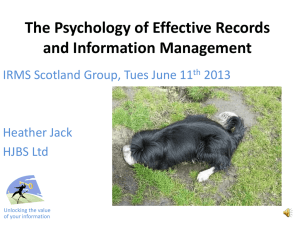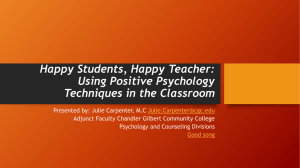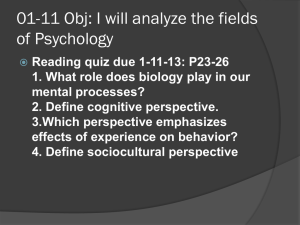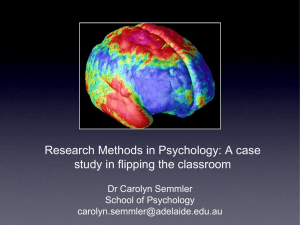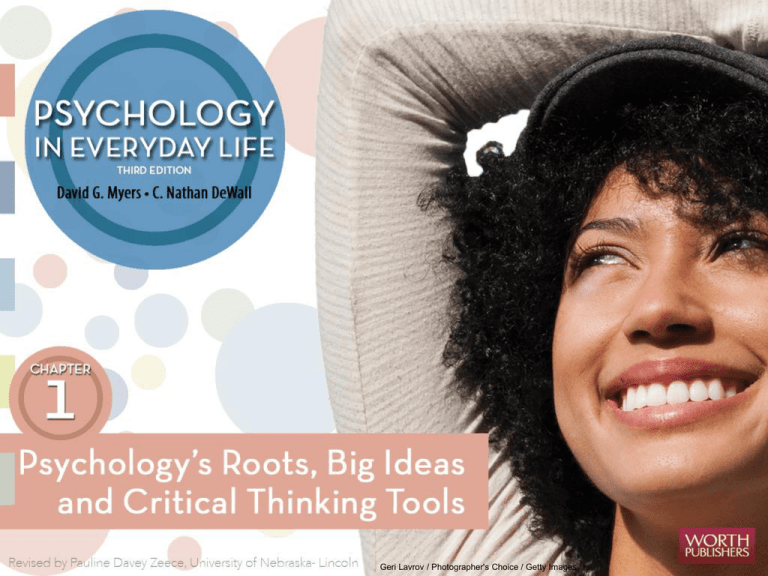
Geri Lavrov / Photographer's Choice / Getty Images
Psychology’s Roots, Big Ideas, and Critical
Thinking Tools
Psychology’s roots
Four big ideas in psychology
Why do psychology?
How do psychologists ask and answer questions?
Frequently asked questions about psychology
Psychology’s Roots
Psychological science is born
Contemporary psychology
Psychological Science Is Born
“Magellans of the mind” (Hunt, 1993)
William Wundt
Darwin
Freud
Piaget
James
Whiton Calkins
Washburn
Psychological Science Is Born
Early definitions until 1920s
Psychology: Science of mental life
Watson and Skinner from 1920s into 1960s
Psychology: Objective science that studies behavior
without reference to mental processes.
Freud
Psychology: Emphasis on unconscious thought
processes and emotional responses to childhood
experiences
Psychological Science Is Born
Rogers and Maslow
Psychology: Humanistic view with emphasis on
growth potential of healthy people
Cognitive psychologists
Psychology: Scientific exploration of how information
is perceived, processed, and remembered
Cognitive neuroscientists
Psychology: Scientific exploration of brain activity
underlying mental activity
Psychology
Science of behavior and mental processes.
Behaviorism
View that psychology should be an objective science
that studies behavior without reference to mental
processes.
Humanistic psychology
Emphasized the growth potential of healthy people.
Psychological
Science Is Born
Today
Psychology: Science of
behavior and mental
processes
Mental processes:
Internal states inferred
from behavior
Science: Key word!
Psychology students, such as
Facebook CEO Mark Zuckerberg
(who majored in psychology
and computer science while at
Harvard), end up in varied careers.
AP Photo/Paul Sakuma, File
Behavior: Anything a
human or nonhuman
animal does
What event defined the start of scientific
psychology?
How did the cognitive revolution affect the field of
psychology?
Psychology’s Current Perspectives
Psychology’s Current Perspectives
Ted Fitzgerald, Pool/ AP Photo
Psychology is both a
science and a profession.
It can take you down many
paths!
PSYCHOLOGY IN COURT Forensic
psychologists apply psychology’s
principles and methods in the criminal
justice system. They may consult on
witnesses, or testify about a defendant’s
state of mind and future risk.
Basic research
Applied research
Many interesting careers
and perspectives
How many of these
careers can you identify?
The ________ perspective in psychology focuses
on how behavior and thought differ from situation
to situation and from culture to culture.
The________ perspective emphasizes how we
learn observable responses?
Four Big Ideas in Psychology
Critical thinking
The biopsychosocial approach
The two-track mind
Exploring human strengths
Let’s take a closer look at each of these.
Big Idea 1: Critical Thinking Is
Smart Thinking
Science supports thinking that examines
assumptions, uncovers hidden values, weighs
evidence, and tests conclusions.
Critical thinkers ask critical questions.
Big Idea 2: Behavior Is a Biopsychosocial
Event
Human behavior can be viewed from three
levels
Biological
Psychological
Social-cultural
Each level’s viewpoint provides a valuable
insight into a behavior or mental process.
Together these provide the most complete
picture.
Biopsychosocial Approach: Three Paths to
Understanding
Critical thinking
Thinking that does not blindly accept arguments and
conclusions. Rather, it examines assumptions, uncovers
hidden values, weighs evidence, and assesses
conclusions.
Biopsychosocial approach
Approach that integrates different but complementary
views from biological, psychological, and social-cultural
viewpoints.
Culture
Enduring behaviors, ideas, attitudes, values, and
traditions shared by a group of people and handed down
from one generation to the next.
Antonia Brune
Roy Toft/National Geographic/ Getty Images
A SMILE IS A SMILE THE WORLD AROUND
Throughout this course, you will see and hear examples not only of our cultural
and gender diversity but also of the similarities that define our shared human
nature.
People in different cultures vary in when and how often they smile, but a
naturally happy smile means the same thing anywhere in the world.
Nature versus nurture
This is an age-old controversy focuses on the
relative influence of genes and experience in the
development of psychological traits and behaviors.
Today’s psychological science sees traits and
behaviors arising from the interaction of nature and
nurture.
In most cases, nurture works on what nature
endows.
Psychologists explore this by asking many
interesting and important questions.
Can you think of any of these?
Westend61 / SuperStock
Big Cheese Photo LLC / Alamy
NATURE-MADE NATURE-NURTURE EXPERIMENT
Identical twins (left) have the same genes. This makes them ideal participants in
studies designed to shed light on hereditary and environmental influences on
personality, intelligence, and other traits. Fraternal twins (right) have different
genes but often share the same environment. Twin studies provide a wealth of
findings—described in later chapters—showing the importance of both nature and
nurture.
Big Idea 3: We Operate With a Two-Track Mind
(Dual Processing)
Much of thinking, feeling, sensing, and
acting operates outside awareness.
The brain works on two tracks through dual
processing.
Conscious mind
Unconscious mind
Contemporary psychological science explores
this dual-processing capacity.
Dual processing
Principle that, at the same time, our mind processes
information on separate conscious and unconscious
tracks.
Positive psychology
Scientific study of human functioning, with the goals
of discovering and promoting strengths and virtues
that help individuals and communities to thrive.
Big Idea 4: Psychology Explores Human
Strengths as Well as Challenges
Early psychology focused on understanding and
treating difficulties.
Contemporary psychology continues this tradition
and extends research to include human flourishing.
Positive psychology uses scientific methods to
explore
Positive emotions
Positive character traits
Positive institutions
Positive Psychology
• Has goals of discovering
and promoting strengths
and virtues that help
individuals and
communities to thrives
MARTIN E. P. SELIGMAN “The main
purpose of a positive psychology is to
measure, understand, and then build
the human strengths and the civic
virtues.”
Courtesy Martin Seligman
• Is the scientific study of
human functioning
Exploring Human Strengths
Positive psychology uses scientific methods
to explore
Positive emotions
Positive character traits
Positive institutions
Will psychology have a more positive mission in this
century? Can it help us all to flourish?
What advantage do we gain by using the
biopsychosocial approach to studying
psychological events?
What is contemporary psychology’s position on the
nature-nurture debate?
Why Do Psychology?
The limits of intuition and common sense
The scientific attitude: Curious, skeptical, and
humble
The Limits of Intuition and Common Sense
Research shows that thinking, memory, and
attitudes often open automatically without
awareness.
But…intuitive thinking has three common flaws.
Hindsight bias
Overconfidence
Perceiving patterns in random events
Did we know it all
along?
REUTERS/ U.S. Coast Guard/ Handout
Hindsight bias
Tendency to believe,
after learning an
outcome, that we could
have predicted it.
Also known as the
I-knew-it-all-along
phenomenon.
HINDSIGHT BIAS When drilling the
Deepwater Horizon oil well in 2010, oil
industry employees took some
shortcuts and ignored some warning
signs, without intending to harm the
environment or their companies’
reputations.
After the resulting Gulf oil spill, with
the benefit of 20/20 hindsight, the
foolishness of those judgments
became obvious.
WREAT → WATER
ETRYN → ENTRY
GRABE → BARGE
• About how many
seconds do you think it
would take you to
unscramble each
anagram?
The Limits of Intuition
and Common Sense
Overconfidence
People tend to think
they know more than
they do.
This occurs in
academic and social
behavior.
People perceive
patterns to make
sense of their world.
Even in random,
unrelated data people
often find order,
because random
sequences often do not
look random.
People trust their
intuition more than they
should because intuitive
thinking is flawed.
Maciej Oleksy /Shutterstock
Perceiving order in
random events
Roland Weihrauch/ dpa/ picture-alliance/ Newscom
Perceiving order in
random events
GIVEN ENOUGH RANDOM EVENTS,
SOME WEIRD-SEEMING STREAKS
WILL OCCUR:
During the 2010 World Cup, a
German octopus—Paul, “the
oracle of Oberhausen”—was
offered two boxes, each with
mussels and with a national
flag on one side.
Paul selected the right box
eight out of eight times in
predicting the outcome of
Germany’s seven matches and
Spain’s triumph in the final.
Why, after friends start dating, do we often feel
that we knew they were meant to be together?
The Scientific Attitude: Curious, Skeptical, and
Humble
Curiosity
Includes a passion to explore and understand the
world without misleading or being misled
Questions to consider
What do you mean?
How do you know?
The Scientific Attitude:
Curious, Skeptical,
and Humble
Skepticism
THE AMAZING RANDI: Magician
and skeptic James Randi has tested
and debunked a variety of psychic
phenomena.
AP Photo/ Alan Diaz
Supports questions
about behavior and
mental processes:
What do you mean?
How do you know?
The Scientific Attitude: Curious, Skeptical, and
Humble
Humility
Involves awareness that mistakes are possible and
willingness to be surprised
One of psychology’s early mottos: “The rat is always
right.”
“For a lot of bad ideas, science is society’s
garbage disposal.” Describe what this tells us
about the scientific attitude.
How Do Psychologists Ask and
Answer Questions?
The scientific method
Description
Correlation
Experimentation
The Scientific Method
Theory
Explanation using an integrated set of principles that organizes
observations and predicts behaviors or events
Hypothesis
Testable prediction, often implied by a theory
Operational definition
Carefully worded statement of the exact procedures (operations)
used in a research study
Replication
Repeating the essence of a research study, usually with different
participants in different situations, to see whether the basic
finding extends to other participants and circumstances
A Good Theory…
Effectively
organizes
Leads to
clear
predictions
Often
stimulates
research
May be
replicated
The Scientific Method
Testing hypothesis and refining theories
Descriptive methods
Correlational methods
Experimental methods
What does a good theory do?
Why is replication important?
Description
Case studies
Naturalistic
observations
• Examines one
individual in
depth
• Records behavior
in natural
environment
• Provides fruitful
ideas
• Describes but
does not explain
behavior
• Cannot be used
to generalize
• Can be revealing
Surveys and
interviews
• Examines many
cases in less
depth
• Wording effect
• Random
sampling
• Utilizes random
sampling of
population for
best results
Case study
Descriptive technique in which one person is studied in depth in
the hope of revealing universal principles
Naturalistic observation
Descriptive technique of observing and recording behavior in
naturally occurring situations without trying to change or control
the situation
Survey
Descriptive technique for obtaining the self- reported attitudes or
behaviors of a group, usually by questioning a representative,
random sample of that group
Population
All those in a group being studied, from which samples may be
drawn (Note: Except for national studies, this does not refer to a
country’s whole population.)
Random sample
Sample that fairly represents a population because each
member has an equal chance of inclusion
We cannot assume that case studies always reveal general
principles that apply to all of us. Why not?
What are the advantages and disadvantages of naturalistic
observation, such as the EARs study?
What is an unrepresentative sample, and how do
researchers avoid it?
Correlation
Positive correlation (between 0 and +1.00)
Indicates a direct relationship, meaning that two things
increase together or decrease together
Negative correlation (between 0 and −1.00)
Indicates an inverse relationship: As one thing increases,
the other decreases.
Correlation coefficient
Provides a statistical measure of how closely two things
vary together and how well one predicts the other
SCATTERPLOT FOR HEIGHT AND WEIGHT
This chart displays data from 20 imagined people, each
represented by a data point. The scattered points reveal
an upward slope, indicating a positive correlation.
Correlation
Measure of the extent to which two events vary
together, and thus of how well either one predicts the
other.
Correlation coefficient
Mathematical expression of the relationship, ranging
from −1.00 to +1.00, with 0 indicating no relationship.
Scatterplot
Graphed cluster of dots, each of which represents the
values of two factors.
Indicate whether each of the following statements
describes a positive correlation or a negative
correlation.
1. The more children and youth used various media, the
less happy they were with their lives (Kaiser, 2010).
2. The more sexual content teens saw on TV, the more
likely they were to have sex (Collins et al., 2004).
3. The longer children were breast-fed, the greater their
later academic achievement (Horwood & Ferguson,
1998).
4. The more income rose among a sample of poor
families, the fewer symptoms of mental illness their
children experienced (Costello et al., 2003).
Nancy Brown/Getty Images
Length of marriage
correlates with hair loss in
men. Does this mean that
marriage causes men to
lose their hair (or that
balding men make better
husbands)?
THREE POSSIBLE CAUSE-EFFECT RELATIONSHIPS
People low in self-esteem are more likely to report
depression than are those high in self-esteem. One
possible explanation of this negative correlation is that a bad
self-image causes depressed feelings. But, as the diagram
indicates, other cause-effect relationships are possible.
Experimentation
With experiments, researchers can focus on
the possible effects of one or more factors in
several ways.
Manipulating the factors of interest to
determine their effects
Holding constant (“controlling”) other factors
Experimental group
Control group
Experimentation
Double-blind procedure: Eliminating bias
Neither those in the study nor those collecting the
data know which group is receiving the treatment.
Treatment’s actual effects can be separated from
potential placebo effect.
Placebo effect
Effect involves results caused by expectations alone.
What measures do researchers use to prevent the
placebo effect from confusing their results?
Experimentation
Variables
that is manipulated;
Independent variable • Factor
the variable whose effect is
in an experiment
being studied
other than the
Confounding variable • Factor
independent variable that
in an experiment
might produce an effect
Dependent variable in
an experiment
• Factor that is measured; the
variable that may change
when the independent
variable is manipulated
Experimentation
To study cause-effect, psychologists may randomly assign some
participants to an dependent variable (intelligence score in later
childhood) will determine the effect of the independent variable
(type of milk).
Comparing Research Methods
Each of psychology’s research methods has strengths and
weaknesses
Match the term on the left with the description on the
right.
1.
Double-blind procedure
a. helps researchers generalize from a
small set of survey responses to a
large population.
2.
Random sampling
b. helps minimize preexisting
differences between experimental and
control groups.
3.
Random assignment
c. controls for the placebo effect;
neither researchers nor participants
know who receives the real treatment.
Why, when testing a new drug to control blood
pressure, would we learn more about its
effectiveness from giving it to half the participants
in a group of 1000 than to all 1000 participants?
Frequently Asked Questions About
Psychology
How do simplified laboratory conditions help
us understand general principles of
behavior? (1-10)
Purpose of experiment is to test theoretical principles.
Resulting principles, not specific findings, help explain
everyday behaviors.
Psychologists are less interested in particular
behaviors than in the general principles that help
explain many behaviors.
Frequently Asked Questions About
Psychology
Why do psychologists study animals, and what
ethical guidelines safeguard human and animal
research participants? (1-11)
Some psychologists study animals to understand about
different species.
Others study animals to learn about humans in a variety of
ways (e.g., insulin; vaccines for polio and rabies;
transplants).
Use of animals for research is debated among
psychologists.
APA has an ethical code applying to all research.
Frequently Asked Questions About
Psychology
How do personal values influence
psychologists’ research and application?
Does psychology aim to manipulate people?
(1-12)
Values impacts what is studied, how it is studied, and
how results are interpreted.
Applied psychology contains hidden values.
There is some concern that psychology is becoming
too powerful.
What do you think?
How are human research participants protected?
Improve Your Retention-and Your
Grades
•
Strategies
•
arabianEye /Getty Images
•
•
•
How can psychological
principles help you
learn and remember? (113)
•
•
Using self-testing and
rehearsal
Implementing SQ3R
study method
Distributing study time
Learning to think
critically
Actively processing
class information
Overlearning
The ________ describes the improved memory
that results from repeated retrieval (as in selftesting) rather than from simple rereading of new
information.
What does SQ3R mean?


